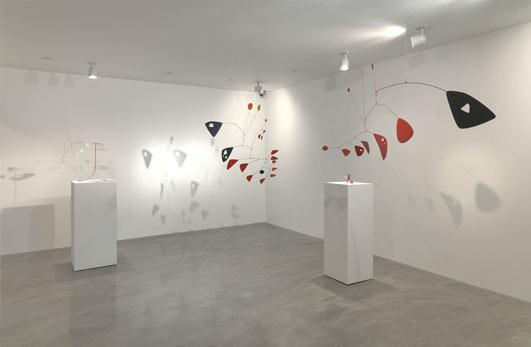Fruit in England is small, and in Mediterranean countries is it enormous. I remember being taken aback that “orange” could mean such totally different fruits. The extension of this, however, becomes eerie. Things, particularly inanimate things like plants or fruits, grown gargantuan but still in precise shapes or patterns, is not quite a trope but is always remembered (by me anyway) from childhood as being sinister because of its super-order and super-fecundity. (I didn’t use those words in childhood, though, I just got shivers). I think it’s this that still happens when I see skeletons of dinosaurs, particularly ones with long necks or tails, or fins for swimming, that are both enormous and weirdly ordered. Ultra-precision is inhuman, and I’ve never managed to work out what it is about this that is so scary- others I have spoken to get the same sort of feeling with blue whales- but I think it is something to do with being kind-of naïvely merciless.
Alexander Calder’s 10 mobiles, 9 made on a trip to India in 1954 plus one sent there in 1952, are not quite big enough to terrify like that, but certainly have the feel of an odd forest, grown through slavish dedication to precise phyllotaxis or the Fibonacci spirals that make them balance perfectly. Perhaps too perfectly, even when ruffled by an air conditioner. This is the first (and the gallery seems to think last, owing to the spread of their owners) opportunity to see all these works together in one place, and before I went I imagined they would be something like a sculptural version of Miró’s “Painting-Poems”- bright colours, dots, vivid colours like happy light, but the need to balance the mobiles as they hang from the ceiling puts an unexpected aspect onto Miró’s jauntiness, as well as the shimmer of fish-scales that fulfils Calder’s ideas about ‘Kinetic Art’- where movement/animation is part of the sculpture.
That is not to say that jauntiness is entirely absent. Black, red (bright, vivid red), and white, with an occasional bright yellow, give a full-sun energy to the works, in particular “Claw” (1955) and “Guava” (1955); the latter of which can’t help but remind me of levels in computer games where the floor would fall from beneath your character if you stood on one platform for too long. The colour is the sort of colour you get from warm climates in full sun, where large hearts and large fruits grow- for Calder it is India, for Miró it was Catalonia/Mallorca, for Terry Frost (who’s colours would become very similar to Calder’s are here) it was St. Ives and the poems of Lorca. It is a colour that is like a warm friendly smile.
And I think individually these pieces, brilliant as they are, do function like Miró in that exuberant way. But put all together, with the strange tubular pops and whizzes and surprises coming from the John Cage-written soundtrack to “Works of Calder” (1950)- a film playing in Ordovas over the top of the exhibition- there is an air of the bedevilled forest to this gallery show, or the weird mystery of bones of aquatic dinosaurs that rock a bit when you breath nearby them.
So there is an unexpected fascination, which throws up one of the more frivolous problems of the world today: is there such a thing as surrealist sculpture? I suppose so, but Miró is free to be surreal because he can represent, he can use paint and words and fling them around and place them as he wishes, not constrained by gravity. But sculpture and mobiles rely on having to keep on our side of mathematical and structural possibility, have to obey certain things in order to not crash down into a heap. The incredible thing about this show is that they are real, that they are precisely balanced. Calder has said: “Nothing at all of this is fixed./Each element able to move, to stir, to oscillate, to come and go in its relationships with the other elements in its universe./It must not be just a fleeting moment but a physical bond between the varying events in life./Not extractions,/But abstractions/Abstractions that are like nothing in life except in their manner of reacting.” And so each part is governed by gravity, in relation to all the other parts and to the air conditioner that blows it, to keep it balanced across. This, despite being like nothing in life except that they are balanced and obey physical laws, like bones of dinosaurs in Museums of Natural History. So they are only “real”, but they seem unlikely. They are like enormous fruits or trees deep in a jungle. You walk into Ordovas and feel like you’ve discovered them, you want to know what natural process made them hang from a ceiling at all, and want to know if you should be scared that a similar thing might happen to you if you stay too long.
Alexander Calder- Calder in India, Ordovas, Saville Row, 31st May- 3rd August
**** 4 Stars Visit Exhibition Here
Words by Jack Castle © Artlyst 2012

